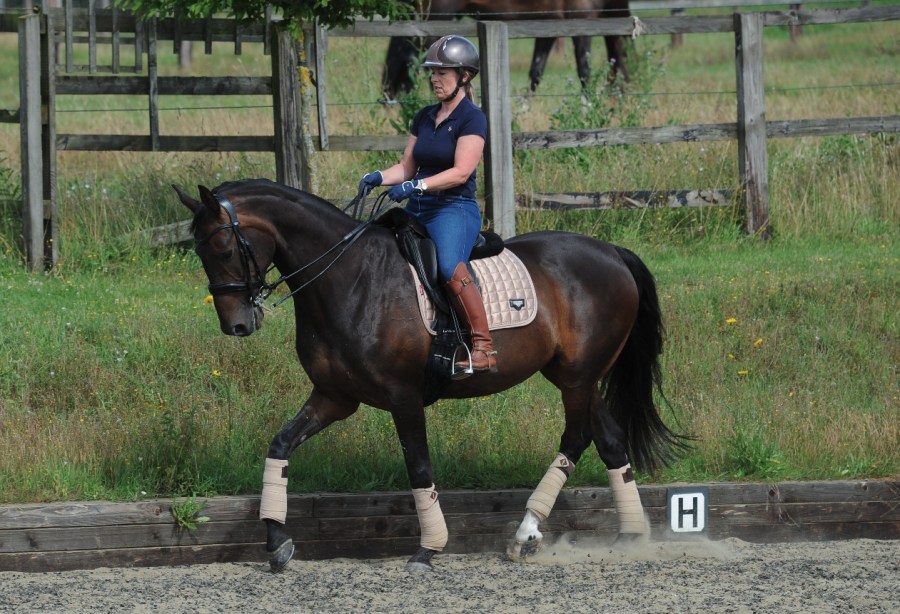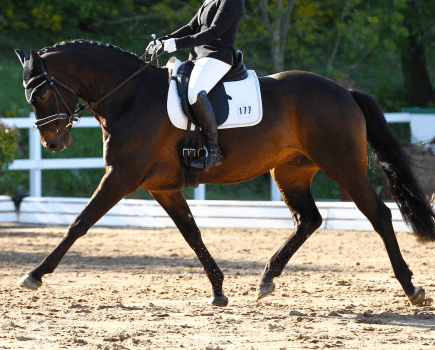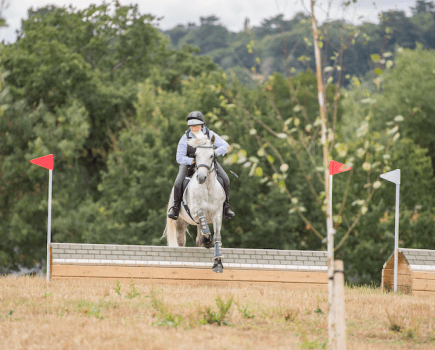Engaging your hips to communicate with your horse achieves balance and symmetry in the dressage arena. FEI judge and CCI4* ground jury member Sandy Phillips explains how to do it.
Dressage is the art of being in balance with your horse – until you have that balance, you can’t put energy into your horse’s movement. You need energy in order to have quality and that in turn leads to higher marks. So, to increase your chances of bagging a glossy red rosette, you need to heed the following advice.
1. Don’t block with your hands
Your hands are the main point of contact with your horse’s mouth, so use them wisely. Obvious, you might say, but it’s a fault that many riders make.
“If you try to control your horse’s front end with your hands, all you do is block the horse’s forwardness,” explains Sandy. “Your hands stop the hindleg stepping through to show enough uphill tendency for an eight from the judge. If you focus on riding the horse’s back end, you’ll improve engagement of the hindquarters and get them off the forehand.”
Achieving this, adds Sandy, is only possible if you have a strong core.
“Every rider must take responsibility for their own fitness so they can ride without depending on their hands to balance.”
2. Learn to control every step
When a horse doesn’t engage and step under with their hindlegs, their point of hock becomes the furthest end of their body and it’s difficult to show they’re uphill and balanced.
“You have to teach the horse to work with their hindleg more under their body so that they get greater lift in their step,” explains Sandy.
She adds that the top-level riders can control the step of their horse’s hindlegs – and you can work towards achieving that too.
“Ride into a corner and ask for a smaller step for the turn. Then ask for a more forward step so you come out of the corner uphill.”
This doesn’t mean blocking with your hand to shorten the step. You should feel the rhythm and, as you ride each step, use your hip to influence it by moving it more or less. This takes practise.
3. Be quiet with your hands
When your horse is working in a pace you’re happy with, sit still. Soon they’ll realise your hands aren’t there to restrict them.
“If you sit back in the saddle to slow down, it’s a negative aid that brings the horse behind the contact,” says Sandy.
Your horse needs to learn to push their shoulders forwards, rather than pulling their hindquarters along.
To achieve this, in sitting trot, use your hips in a quicker rhythm to encourage your horse to spring off the ground. Remember that when you’re rising, a bigger rise by you leads to a slower step by the horse.
4. Ride the correct beat
Canter is a three-beat gait and you need to ride forwards on the first beat so that your horse is light in front and lifts their forehand.
Count the three beats out loud. This is often more effective than counting in your head. It will help you establish a regular rhythm and recognise the first beat, which is when the outside hindleg touches the ground.
“This makes the horse push their back end forwards into the ‘one’ beat,” explains Sandy. “Don’t drive on to get the forwardness. All that does is make the pace flat.
“The haunches need enough time to take the weight so that the back end can lift the front. A flat canter stride makes this harder to achieve and the smaller the circle, the more you have to let them jump.”
5. Find the sweet spot
Monitor exactly where you’re sitting in the saddle.
“There’s a spot where, every time you rise, the hindleg moves and steps under. So you’re not following the trot, the hindleg moves with you,” says Sandy. “You don’t want to be a passenger. You are the leader in this dance and you control where they put their feet. Then you can control the size of the step.”
Be totally black and white about when you want your horse to go forwards or to shorten their step. This is how you should think about slowing down – doing it in an active way.
6. Half-halt with your hips
“Horses spook because they’re behind the leg,” explains Sandy. “Stop and starting your hip is your half-halt. All you’re doing is following the movement with your hip and then not following.”
She adds that half-halting with your hands is a backwards aid, because it starts at the front of the horse and prevents the hindleg stepping through. Using your seat instead shortens the step without taking away the activeness.
“Putting your leg on doesn’t have to mean forwards and faster either. You want spring in their step so that it gives them more air time to get their hindleg under,” says Sandy.
Meet the expert: Sandy Phillips is a former international dressage rider and eventer who represented her native USA at one Olympics and three world championships. She was a British Dressage team selector until 2012 and is an FEI ‘I’ judge for both disciplines.
Check out our subscription offer









